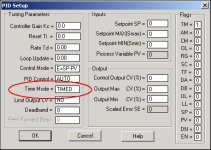from naegely:
Is it true that a PID in an SLC (e.g. 5/04) will automatically synchronize based on the LUT, and can therefore be on a rung without conditions?
maybe yes ... maybe no ...
be sure that you fully understand how the "Time Mode" setting works before you jump into the pool ...
basic idea: if set for "TIMED" then the operation will be as you mentioned ... specifically, the "Loop Update" setting uses the PID's internal clock/timer to automatically "trigger" the PID into execution ...
but ...
if set for "STI" then the PID's internal clock/timer is NOT used - and the PID will execute/calculate each and every time that its rung is executed by the processor ... in this arrangement the PID should be placed in a Selectable Timed Interrupt file - whose "Period" should be set to match the PID's Loop Update setting ...
in BOTH cases, the PID rung in an SLC/MicroLogix system should always be UNconditional (no XIC, no XIO, etc.) ... AND - an external "trigger timer" will never be used ...
note that STI is the "default - fresh out of the box" setting - and these issues are some of the first things that we check when troubleshooting a PID in an SLC/MicroLogix system ... quite often they are set up wrong ...
PS ... if you have other questions along these lines, it would probably be best to start a new topic and discuss them there ... there is already a lot going on in this present thread and we really shouldn't distract the focus by bringing extra platforms into the mix ...






